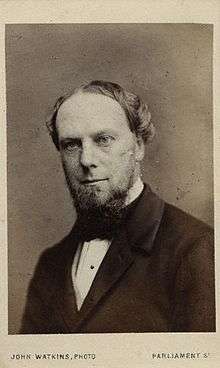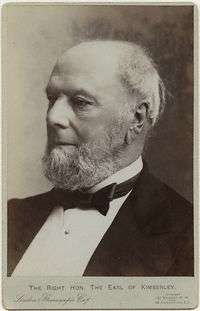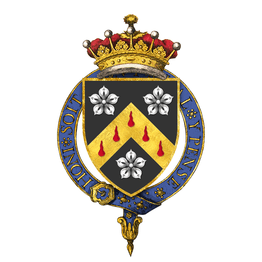John Wodehouse, 1st Earl of Kimberley
John Wodehouse, 1st Earl of Kimberley KG KP PC DL (7 January 1826 – 8 April 1902), known as The 3rd Baron Wodehouse from 1846 to 1866, was a British Liberal politician. He held office in every Liberal administration from 1852 to 1895, notably as Secretary of State for the Colonies and as Foreign Secretary.
The Earl of Kimberley KG KP PC DL | |
|---|---|
 Carte de visite showing the Earl of Kimberley, ca. 1868. | |
| Secretary of State for Foreign Affairs | |
| In office 10 March 1894 – 21 June 1895 | |
| Monarch | Queen Victoria |
| Prime Minister | The Earl of Rosebery |
| Preceded by | The Earl of Rosebery |
| Succeeded by | The Marquess of Salisbury |
| Lord President of the Council | |
| In office 18 August 1892 – 10 March 1894 | |
| Monarch | Victoria |
| Prime Minister | William Ewart Gladstone |
| Preceded by | The Earl of Cranbrook |
| Succeeded by | The Earl of Rosebery |
| Chancellor of the Duchy of Lancaster | |
| In office 25 July – 28 December 1882 | |
| Monarch | Queen Victoria |
| Prime Minister | William Ewart Gladstone |
| Preceded by | John Bright |
| Succeeded by | John George Dodson |
| Lord Lieutenant of Ireland | |
| In office 1 November 1864 – 13 July 1866 | |
| Monarch | Queen Victoria |
| Prime Minister | The Earl Russell |
| Preceded by | The Earl of Carlisle |
| Succeeded by | The Marquess of Abercorn |
| Personal details | |
| Born | 7 January 1826 Wymondham |
| Died | 8 April 1902 (aged 76) London |
| Nationality | British |
| Political party | Liberal Party |
| Spouse(s) | Lady Florence FitzGibbon (d. 1895) |
| Alma mater | Christ Church, Oxford |
Early life and education
Kimberley was born in 1826 in Wymondham, Norfolk, the eldest son of the Hon. Henry Wodehouse (1799–1834) and grandson of John Wodehouse, 2nd Baron Wodehouse.[1] His mother was Anne Gurdon (d. 1880), daughter of Theophilus Thornhagh Gurdon. In 1846 he succeeded his grandfather as third Baron Wodehouse. He was educated at Eton and Christ Church, Oxford, where he took a first-class degree in classics in 1847.[1][2]
Early career (1852–1874)
He was by inheritance a Liberal in politics, and in 1852–1856 and 1859–1861 he was Parliamentary Under-Secretary of State for Foreign Affairs in Lord Aberdeen's and Lord Palmerston's ministries. In the interval (1856–1858) he had been envoy-extraordinary to Russia; and in 1863 he was sent on a special mission to Copenhagen in the hope of finding a solution to the Schleswig-Holstein question. However, the mission was a failure.[1]
In 1864 Kimberley became Under-Secretary of State for India, but towards the end of the year was made Lord Lieutenant of Ireland. In that capacity, he had to grapple with the first manifestations of Fenianism, and in recognition of his services, he was created Earl of Kimberley in 1866. In July 1866 he vacated his office with the fall of Lord Russell's ministry, but in 1868 he became Lord Privy Seal in Gladstone's cabinet, and in July 1870 was transferred from that post to be Secretary of State for the Colonies. It was the moment of the great diamond discoveries in southern Africa, and the town of Kimberley in the Cape Colony was named after him.[1] Lord Kimberley has been credited with the change in British policy towards the independent Malay states that led to the signing of the Pangkor Treaty of 1874, after which British political agents known as Residents were placed in the Malay states as advisors to the rulers.[3]
Later career (1875–1902)


After an interval in opposition from 1874 to 1880, Lord Kimberley returned to the Colonial Office in Gladstone's next ministry. He was in that office when responsible government was granted to Cape Colony, British Columbia was added to the Dominion of Canada and during the First Boer War. At the end of 1882 he exchanged this office first for that of Chancellor of the Duchy of Lancaster and then for the secretaryship of state for India, a post he retained during the remainder of Gladstone's tenure of power (1882–1885, 1886, 1892–1894), though in 1892–1894 he combined with it that of the lord presidency of the council.[1]
In Lord Rosebery's cabinet (1894–1895) he was Foreign Secretary. During this time he signed the landmark Anglo-Japanese Treaty of Commerce and Navigation. Sir Edward Grey who served as Parliamentary Under-Secretary under Kimberley at the Foreign Office portrays him unfavourably as prolix and prone to irrelevant digressions in conversation although concise, definite and clear on paper.[4] However, according to the Encyclopædia Britannica Eleventh Edition, "As leader of the Liberal party in the House of Lords he acted with undeviating dignity, and in opposition, he was a courteous antagonist and a critic of weight and experience".[5]
Other public positions
On 5 April 1850, he joined the Canterbury Association, formed to establish a colony (in the later Canterbury region) on the South Island of New Zealand.
Lord Kimberley took interest in education, and after being for many years a member of the senate of the University of London, he became its chancellor in 1899.[1]
Family
Lord Kimberley married Lady Florence FitzGibbon (d. 1895), daughter of Richard FitzGibbon, 3rd Earl of Clare, on 16 August 1847.[2] He died at 35 Lowndes Square in London (now the High Commission of Pakistan) on 8 April 1902,[2] aged 76, and was succeeded in his titles by his eldest son, John.[1] His second son, the Hon. Armine Wodehouse, was also a Liberal politician but died at an early age. His more distant relations include the writer P. G. Wodehouse.
Ancestry
| Ancestors of John Wodehouse, 1st Earl of Kimberley | ||||||||||||||||||||||||||||||||||||||||||||||||||||||||||||||||||||||||||||||||||||||||||||||||||||||||||||||||||||||||||||||||||||||||||||||||||||||||||||||||||||||||||||||||||||||||||||||||||||||||||||||||||||||||||||||||||||||||||||||||||||||||||||||||||||||||||||||||||||||||||||||||||||||||||||||||||||||||||||||||||||||||||||||||||||||||||||||||||||||||||||||||||||||||||||||||||||||||||||||||||||||||||||||||||||||||||||||||||||||||||||||||||||||||||||||||||||||||||||||||||||||||||||||||||||||||||||||||||||||||||||||||||||||||||||||||||||||||||||||||||||||||||||||||||||||||||||||||
|---|---|---|---|---|---|---|---|---|---|---|---|---|---|---|---|---|---|---|---|---|---|---|---|---|---|---|---|---|---|---|---|---|---|---|---|---|---|---|---|---|---|---|---|---|---|---|---|---|---|---|---|---|---|---|---|---|---|---|---|---|---|---|---|---|---|---|---|---|---|---|---|---|---|---|---|---|---|---|---|---|---|---|---|---|---|---|---|---|---|---|---|---|---|---|---|---|---|---|---|---|---|---|---|---|---|---|---|---|---|---|---|---|---|---|---|---|---|---|---|---|---|---|---|---|---|---|---|---|---|---|---|---|---|---|---|---|---|---|---|---|---|---|---|---|---|---|---|---|---|---|---|---|---|---|---|---|---|---|---|---|---|---|---|---|---|---|---|---|---|---|---|---|---|---|---|---|---|---|---|---|---|---|---|---|---|---|---|---|---|---|---|---|---|---|---|---|---|---|---|---|---|---|---|---|---|---|---|---|---|---|---|---|---|---|---|---|---|---|---|---|---|---|---|---|---|---|---|---|---|---|---|---|---|---|---|---|---|---|---|---|---|---|---|---|---|---|---|---|---|---|---|---|---|---|---|---|---|---|---|---|---|---|---|---|---|---|---|---|---|---|---|---|---|---|---|---|---|---|---|---|---|---|---|---|---|---|---|---|---|---|---|---|---|---|---|---|---|---|---|---|---|---|---|---|---|---|---|---|---|---|---|---|---|---|---|---|---|---|---|---|---|---|---|---|---|---|---|---|---|---|---|---|---|---|---|---|---|---|---|---|---|---|---|---|---|---|---|---|---|---|---|---|---|---|---|---|---|---|---|---|---|---|---|---|---|---|---|---|---|---|---|---|---|---|---|---|---|---|---|---|---|---|---|---|---|---|---|---|---|---|---|---|---|---|---|---|---|---|---|---|---|---|---|---|---|---|---|---|---|---|---|---|---|---|---|---|---|---|---|---|---|---|---|---|---|---|---|---|---|---|---|---|---|---|---|---|---|---|---|---|---|---|---|---|---|---|---|---|---|---|---|---|---|---|---|---|---|---|---|---|---|---|---|---|---|---|---|---|---|---|---|---|---|---|---|---|---|---|---|---|---|---|---|---|---|---|---|---|---|---|---|---|---|---|---|---|---|---|---|---|---|---|---|---|---|---|---|---|---|---|---|---|---|---|---|---|---|---|---|---|---|---|---|---|---|---|---|---|---|---|---|---|---|---|---|---|---|---|---|---|---|---|---|---|---|---|---|---|---|---|---|---|---|---|---|---|---|---|---|---|---|---|---|---|---|---|---|---|---|---|---|---|---|---|---|---|---|---|---|---|---|---|---|---|---|---|---|---|---|---|---|---|
| ||||||||||||||||||||||||||||||||||||||||||||||||||||||||||||||||||||||||||||||||||||||||||||||||||||||||||||||||||||||||||||||||||||||||||||||||||||||||||||||||||||||||||||||||||||||||||||||||||||||||||||||||||||||||||||||||||||||||||||||||||||||||||||||||||||||||||||||||||||||||||||||||||||||||||||||||||||||||||||||||||||||||||||||||||||||||||||||||||||||||||||||||||||||||||||||||||||||||||||||||||||||||||||||||||||||||||||||||||||||||||||||||||||||||||||||||||||||||||||||||||||||||||||||||||||||||||||||||||||||||||||||||||||||||||||||||||||||||||||||||||||||||||||||||||||||||||||||||
Memorials
The following places were named after the 1st Earl of Kimberley:
- the Kimberley region of Western Australia;
- Kimberley, a town in South Africa and;
- Kimberley, New Zealand, a hamlet of in the Selwyn District.[31]
- Kimberley Road in Hong Kong[32]
- Kimberley Street, George Town, Penang, Malaysia
- Kimberley Park, Falmouth, Cornwall
- County of Kimberley, a cadastral unit in South Australia.[33]
Notes
- Chisholm 1911, pp. 798–799.
- Bain 2007, p. 92.
- Swettenham, Frank (1941). Footprints in Malaya. London, New York, Melbourne: Hutchinson & Co. p. 32.
- Viscount Grey, Twenty Five Years, 1892–1916 (London, 1925) p.18.
- Chisholm 1911, p. 799.
- Cokayne (1892) p. 337
- Cokayne (1892), p. 336
- Cokayne (1892), p. 336 ; daughter of Sir Edmund Bacon, 6th Bart.
- Cokayne, (1892), p. 336 ; daughter of Col. John West.
- Wroth (1895), p. 137.
- Cokayne (1892), p. 337 ; of Witton Park and Witchingham, Norfolk.
- Wroth (1895), p. 137 ; founder of the Norrisian Professorship at Cambridge.
- Wroth (1895), p. 137 ; only gives surname.
- Burke (1858), p. 182 ; daughter of Thomas Carthew, JP, of Benacre Hall and Woodbridge Abbey.
- Collins (1779), p. 49 ; daughter of "Brigadier-General Price".
- Wright (1836), p. 252 ; daughter of Major-General John Price (died 1747 at Breda) and his wife, a daughter of Matthew Martin of Wivenhoe.
- Burke and Burke (1847), p. 515 ; died 1783.
- Burke and Burke (1847), p. 515 ; later Brampton Gurdon Dillingham ; Sheriff of Norfolk in 1789, died in 1820.
- Burke and Burke (1847), p. 515 ; daughter of Theophilus Dillingham of Shelton, Buckinghamshire.
- Burke and Burke (1847), p. 515 ; of Ditchingham.
- Burke and Burke (1847), p. 515 ; his first wife.
- Crisp (1911), p. 116 ; daughter of Sir Edmund Bacon of Gillingham, Norfolk, Baronet.
- Foster (1895), p. 978 ; of Doncaster and Blythe ; son of Samuel Mellish of Doncaster, JP and DL for Yorkshire.
- Burke and Burke (1847), p. 514
- Foster (1895), p. 978 ; daughter of Sir William Gore, Alderman of London and Lord Mayor.
- "Biography of William Mellish (1708-1791)", nottingham.ac.uk - The University of Nottingham. (Accessed 4 September 2014).
- Familiae Minorum Gentium, p. 978 ; son of Sir William Gore.
- Hunter (1895), p. 978
- Crisp (1911), p. 116 ; daughter of John Gore of Bushill, Middlesex.
- R.R. Sedgwick, "Gore, John (c.1689-1763), of Bush Hill, Mdx.", The History of Parliament: the House of Commons 1715–1754, ed. R. Sedgwick, 1970 ; daughter of Sir Jeremy Sambrooke of North Mimms, Hertfordshire.
- Bain 2007, pp. 92–93.
- Bloomfield, Frena (1984). Hong Kong's Street Names and Their Origins. Vol.1. Urban Council, Hong Kong. ASIN B000HZIVAE. OCLC 320407030. Archived from the original on 7 November 2014.
- Manning, Geoffrey. "South Australian Names - K" (PDF). Manning Index of South Australian History. State Library of South Australia. Retrieved 26 December 2018.
References
- Bain, Rev. Michael (2007). The Canterbury Association (1848–1852): A Study of Its Members' Connections (PDF). Christchurch: Project Canterbury. Retrieved 22 September 2012.
- Burke and Burke (1847). A Genealogical and Heraldic Dictionary of the Landed Gentry of Great Britain and Ireland, volume 1 (London: Henry Colburn).
- Burke, J.B. (1858). A Genealogical and Heraldic Dictionary of the Landed Gentry of Great Britain and Ireland (London: Harrison).
- Hunter, J. and Clay, J.W. (ed.) (1895). Familiae Minorum Gentium, volume 3. (London: Harleian Society).
- Cokayne, G.E. (1892). Complete Peerage, 1st edition, volume 4 (London: George Bell and Sons; Exeter: William Pollard & Co.)
- Collins, A. (1779). [books.google.co.uk/books?id=zfk-AQAAMAAJ The Peerage of England], 5th edition, volume 6.
- Crisp, F.A. (1911). Visitation of England and Wales: Notes, volume 9 (printed privately).
- Wright, T. (1836). The History and Topography of the County of Essex, volume 1.
- Wroth, W.W. (1895). "Norris, John (1754-1777)", Dictionary of National Biography, volume 41.
Attribution:

External links
| Wikimedia Commons has media related to John Wodehouse, 1st Earl of Kimberley. |
- Hansard 1803–2005: contributions in Parliament by the Earl of Kimberley
- "Archival material relating to John Wodehouse, 1st Earl of Kimberley". UK National Archives.

- Portraits of John Wodehouse, 1st Earl of Kimberley at the National Portrait Gallery, London

.svg.png)